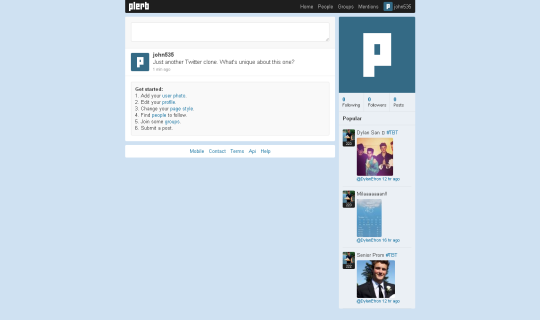Are you losing customers to website masturbation?

He was busted.
After arresting a few others, detectives zeroed in on one of the men they caught masturbating.
Detectives looking for an arrest would visit pornographic theaters and watch the audience. Anyone engaged in “indecent exposure” was arrested.
One of the detectives who had been watching Paul Reubens stopped him on his way out where he was also arrested.
Paul Rubens, better known as Pee-wee Herman, was a popular cult figure in the 80’s and early 90’s. But that all changed after his arrest. Suddenly he was a pariah, a late night punchline. His acting career shriveled up as gigs and opportunities disappeared overnight.
Website masturbation has the same shriveling effect on your business.
But before we can talk about the downsides to website masturbation we need to define it. So here’s our definition.
website masturbation [web-sahyt mas-ter-bey-shuhn]
noun
Self-absorbed, self-serving communication that’s focused away from the needs of your customers and your audience.
This includes the tangible and intangible aspects of your website. It could be your content, your graphics, tone or even attitude. It could be your topic or your ideas. If your communication is focused primarily on you, it’s masturbation.
But the confusing part about website masturbation is how it looks.
Two businesses can say and do similar things. One gets an A for effort while the other comes off as a raging narcissist. And to make matters worse, there are times when doing things the right way comes off as masturbatory.
So what does website masturbation look like?
Focus and intent are the deciding factors. Self-absorbed doesn’t automatically mean selfish. That said, there’s a few telltale signs you can use to identify self-absorbed communication.
Jargon, slang and insider speak
Jargon’s fine when you’re talking to insiders, but it’s meaningless to outsiders. Customers are usually outsiders so that creates an obvious problem. Jargon hides the real meaning behind what you’re trying to say, it creates confusion and increases cognitive load.
Take this image for example:

How’d you feel after trying to read that mess?
Jargon and complex words take more time and more brainpower to process. Which is really bad for business if you need people to do something for you (like give you money). If customers don’t understand what you’re saying or they’re unwilling to take the time, they won’t do what you want them to do.
Jargon makes sense when you’re talking to other people that are “in the know”. It also makes sense when jargon is the product which is usually the case in a highly technical environment.
Narcissism and ego-bait
Entrepreneurs that struggle with narcissism tend to run their business and websites differently. They use more first person pronouns (I and we) in their website copy. They push for the hero shot. They spend more time talking about their killer product or amazing company and less time on their customers or their problems.
As a result, they focus on the wrong problems. They miss objections customers need answered. Or focus on things customers don’t care about. When it comes to their customers, they’re out of touch. So customers don’t convert and they refuse to buy.
Oddly enough, it’s this kind of narcissism that sucks businesses into the “beauty without benefits” trap.
The shameless copycat
Remember how I said that self-absorbed doesn’t necessarily mean selfish? Shameless copycats are the exception to that rule. These guys are in it for themselves. If someone’s making money, they’re looking to hitch a ride on that bandwagon.
I’m not talking about those that use someone else’s work as inspiration. I’m not even talking about those that reference someone else’s work in their material. I’m talking about the bottom feeders that exist to cash in on someone else’s success and hard work through theft. Here’s an example.
Twitter launched in 2006 and quickly became a worldwide hit. In less than two years, the internet was flooded with more than 250 Twitter clones. Most of these clones were garbage. There was no uniqueness, no problem being solved.
We’ve seen hundreds of requests from people who simply want to “clone” an existing website. An eBay clone for $5.99. A Turbotax “clone” for $3,500. An Airbnb clone for $25,000. You’d be right if you guessed that “clone” is a code word for steal.
Shameless copycats aren’t looking to add value, they’re looking to cash in – which qualifies as public masturbation.
Beauty without benefit.
You’ve seen it. The beautifully designed, award winning website filled with all the bells and whistles you’d expect. But they’re missing the important stuff, the key elements that matter most.
As soon as I land on this page I’m overwhelmed. There’s music and sound effects; lots of things moving around on my screen, but no direction. If you’re like me, you land on a web page like this and immediately run into trouble. The site’s pretty but…
- I have no idea what it’s for.
- There’s so much going on I can’t get the site to work properly.
- I have to wait for the animation to load, stop or change before I can do anything.
- There’s no unique or compelling reason for me to even stick around.
- What am I supposed to do? Where do I go?
I don’t think the example above was made for people that actually buy Toyotas. Maybe it was a puff piece or something to make the execs feel good. Is the average customer going to spend a few minutes stumbling around trying to figure out how to use this site? Probably not.
The beauty problem comes from a goal mismatch. The designer/creative team believes they’re creating a beautiful work of art. The customer has a problem they want solved.
Art serves the artist. Design serves the client. Art is about self expression. It’s masturbatory by nature (which is fine in the right context). Design is intended to serve someone other than the designer. Which means you need a totally different mindset.
The ideological ambush
Picture this.
You’re shopping for shoes at a new online store.
They sell discontinued shoes and you’re looking for a specific brand. Their pricing is awesome but you’re a little nervous. You’re using this site for the first time, so naturally you have questions about the people in charge. You go to their about page and scope things out.
You read about how they’re a family business. How they’ve got a passion for shoes. How they started in their garage. Then suddenly, out of nowhere, they hit you with something like this:
“I am washed in the blood of the Lamb. Jesus Christ is my personal Lord and Savior. I believe in the Holy Trinity and thank Jesus for dying on the cross to save me from my sins.”
You’re just looking for shoes, what gives?
That my friend, is an ideological ambush. It’s disorienting and upsetting if the person you’re talking to is totally unprepared for that. Imagine going to the grocery store, meeting the store manager for the first time and hearing about how much his marriage sucks?
Awkward right?
That’s what an ideological ambush feels like.
And it can be done with religion, animal rights, politics, veganism, global warming — anything really.
Now, is it wrong to talk about that stuff? Are you out of line for taking a stand? Not at all. There’s nothing wrong with any of those things. But presentation and relevance should dictate when and how you share. Throwing an ideological grenade at your customer freaks them out. Make sure they’re ready. Don’t treat your values and beliefs like an accessory when they deserve prime time.
Want your beliefs and values to be part of your business? Be consistent, keep it relevant and embody your values.
Where are you losing customers to website masturbation?
Testing’s the best way to find out. Split test your content and design elements. Use readability tests to identify any comprehension issues.
Look at your analytics.
Where are customers leaving? How are your utility pages performing? What about your landing pages? Which pages have the highest amount of exits and why? When in doubt, interview your visitors and customers.
In our experience, we’ve seen that content [copy + design] has the biggest impact on attraction and conversion rates. You should test the issues we’ve discussed here, but focus on any problem areas we haven’t covered that may meet the definition we’ve outlined.
Website masturbation is okay
If you’re in a situation where you’re expected to talk about yourself, people are usually okay with it. So long as there’s an implied understanding or expectation there.
If you’ve created a short film and you’re taking viewers behind-the-scenes, it makes sense to talk about yourself and your work. Of course viewers want you to talk about who you are, what you do and how things work.
If you’re an artist, that comes with the unspoken understanding you’re expressing yourself through your art. Of course you’ll post your artwork and share your backstory.
In a situation where you’re expected to share your feelings or something personal, there’s an unspoken understanding you’ll be talking about yourself.
But when there’s no expectation, you run the risk of losing potential customers which are turned away by website masturbation.
So here’s how you avoid that.
Remember our definition?
website masturbation [web-sahyt mas-ter-bey-shuhn]
noun
Self-absorbed, self-serving communication that’s focused away from the needs of your customers and your audience.
Simply do the opposite. Find your ideal customers, the ones that are willing and able to buy. Talk to them, take the time to understand them. Listen to their problems, their objections, their hopes and dreams — anything they’re willing to share.
You need them to share with you.
Because it gives you a deep, sometimes intimate, understanding of your customers as people. Suddenly, you know how to talk to them. You know their likes and dislikes. You know how you need to serve them.
This has an amazing effect on your business. When you know how to communicate with customers, website masturbation stops being a problem.
“We don’t use our website to generate leads or sell stuff anyway so it’s not a problem for us”
Except that it is. You may not use your website to generate leads or sell products directly, but that doesn’t mean your self-serving content isn’t pushing customers away. Any mistake (including ones we didn’t mention) affect your ability to win customers, whether you sell online or not. It’s easy to think it’s not a problem if you can’t see what you’re losing; testing changes all that.
“Yeah, well you’re offensive. I don’t agree that talking about myself will turn customers away and I don’t think it’s masturbatory.”
You don’t have to like the metaphor, but don’t miss the point. When customers are looking for information to help them solve their problems, you’re the last thing on their mind. When they’re interested in what you can do for them they’ll look into who you are. They’ll want to know more about you, at that point they’re ready for you to talk about yourself.
If your website is all about you, you’re doing it wrong.
You won’t get arrested for doing a digital ego stroke but if your communication is self-serving it’s still indecent exposure. Have you been on the receiving end of website masturbation? What was that like for you?



